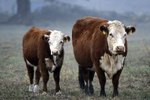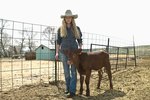
Most calves will stand by themselves within the first 30 minutes following birth, although some calves take up to two hours. For those who can’t seem to get up on their own, you may need to step in and lend a helping hand.
Pump Him Full of Calories
Some calves may be too weak to stand directly after delivery. Provide a bottle of colostrum to supply an immediate source of energy. Milk the cow or use colostrum replacement to fill the bottle. Colostrum is the first milk a mother cow produces. It is thicker than regular milk and is higher in energy and antibodies, supplying the calf with the vital nutrients he needs to boost his immune system and give him a healthy start in life. Newborn calves need to drink 1 or 2 quarts of milk within the first two hours of birth. However, if your goal is to provide enough energy to help the calf stand and start nursing on his own, feed 1 pint of colostrum. Calves who do not drink colostrum immediately following birth are more likely to develop illness or disease within the first few weeks of life.
Warm Him Up
A cold, shivering calf may have difficulty standing. Newborn calves cannot tolerate temperatures below 50 degrees. Provide your heifer with a warm, dry shelter for calving. If your cow gives birth outside in harsh weather conditions, you may need to move her and the baby indoors. If your barn or shelter has a concrete or dirt floor, spread a thick layer of hay or straw for insulation. Ensure that your calf is protected against wind and drafts, which can further deplete his energy stores. As the calf’s body temperature rises, his ability to stand will greatly increase.
Encourage the Mothering Instinct
The mother cow is an important to helping a calf stand for the first time. Licking and nuzzling will stimulate the calf’s muscles and encourage movement. Most cows automatically tend to their newborns. But sometimes this process is obstructed, such as caused by a C-section or a first-time mother's inexperience. C-sections can delay the mothering instinct due to the inadequate release of the hormone oxytocin, which is triggered by the calf passing through the cervix. With a C-section, the calf is removed before traveling completely down the birth canal, bypassing cervical stimulation and the proper release of hormones. In such instances, you can encourage a cow to nuzzle her calf and help him stand. Smear amniotic fluid across her nose. This may trigger the mothering instinct. Spread grain or feed across the newborn’s back and place him in front of his mother to encourage licking. Provide adequate space and privacy for the mother and calf. If your new mother is surrounded by other cows, they may intimidate her.
Lift Him Up Yourself
If a calf is struggling to stand, physically pick him up and place his wobbly legs on the ground. Hold him steadily to help him gain balance. Remove the calf from the puddle of birth fluid so he can gain a more stable, less slippery footing. Sometimes a little assistance is all a newborn calf needs. Gently place the calf under his mother so he can start nursing.
References
- Storey's Guide to Raising Beef Cattle; Heather Smith Thomas
- Calving Ease: Cold Weather and Newborn Calves
- Progressive Cattleman: Helping the Newborn Calf Get a Good Start
- Beef Magazine: Understanding Maternal Behavior Helps In Bonding
- Virginia Cooperative Extension: The Cow-Calf Manager - First 72 Hours Critical for Calves
Photo Credits
-
John Foxx/Stockbyte/Getty Images




